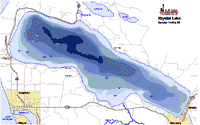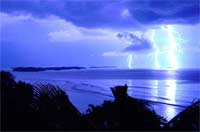| An
Encounter with Lightning
Here is a short scenario
that has always left me wondering if I did the right
thing in response to novel circumstances.
For several years, I vacationed at Crystal Lake,
Michigan in the upper part of the Lower Peninsula
near Frankfort, Michigan. At about 12 miles long and
about 6 miles across, Crystal Lake is one of the premier
small boat sailing venues in the Midwest. The water
is a deep cobalt blue, and being only a mile or two
inland of Lake Michigan, the wind is usually a steady
west to east flow in the teens for most of the summer
months. Sailing a small boat on this lake was about
as close to nautical perfection as I ever encountered.
 |
Crystal Lake
is one of the premier small boat sailing venues
in the Midwest. |
On the August day in question, I was sailing an old
Super Porpoise, a Sunfish clone a little bigger than
its Sunfish ancestor. The boat sported a short mast
and lateen sail along with a self-bailing cockpit.
On this particular day the wind was light and the
atmosphere was uncharacteristically muggy. After an
hour or so, I found myself completely becalmed near
the center of the lake. Knowing that calms were rare
on this lake, I resigned myself to wait it out before
wearing myself out paddling for my home beach several
miles away. Count this decision as mistake #1. I should
have read the ominous signs and paddled to the nearest
shore.
The calm persisted. I had a clear view toward the
west side of the lake and to my horror I saw a classic
line squall bearing down on me and my becalmed boat
at an alarming rate of speed. The leading edge of
the squall line was jagged, full of rain and possibly
hail, and looked grey/white in color – like
the underbelly of a Great White Shark (all negative
connotations intended!) I had been in several squalls
like this before, and while rather exciting, they
didn’t strike me as all that dangerous. However,
this squall was full of lightning with many full cloud
to ground strikes occurring every few seconds. I have
a healthy respect for lightning but as the squall
approached, that respect starting changing to fear.
I knew that life was about to get very interesting
in the next few minutes.
Thinking back to my Boy Scout days, I recalled that
lightning is likely to strike the highest object on
a surface, and at this exact moment, the highest object
on my patch of Crystal Lake was the peak of the aluminum
gaff on my boat! I considered lowering the sail and
unsteping the mast but at the rate the squall was
bearing down on me, I wasn’t sure I had enough
time, and even if I did, I would still have a partially
furled, wet sail and a lot of metal spars on the deck.
Abandoning the first plan, I decided to intentionally
capsize the boat with the sail still fully hoisted.
By standing on the side of the deck and pulling on
the mast, I got the boat on its side. I then continued
to push the rig down until the hull “turned
turtle” and was completely upside down. The
lake was over 100 feet deep at this spot, so there
was no danger of getting the rig stuck in the bottom
and with the boat turtled and the dagger board and
rudder retracted, the hull was almost awash or at
best a few inches above the surface. I was wearing
a good PFD, and swam to the windward side of the hull
looping the mainsheet around my waist. I hunkered
down low in the water near the hull and braced myself
for the onslaught.
 |
Given the short
interval between each flash and report, I knew
that the lightning was virtually on top of me.
|
The squall hit only seconds after I got in the water,
and it was quite a show. The sky turned black as night,
rain and hail pelted the surface of the lake and I
estimated the wind at somewhere between 50 and 60
mph. The lake surface went from flat to whitecaps
in a matter of seconds. The black sky was punctuated
with flashes of lightning, and given the short interval
between each flash and report, I knew that the lightning
was virtually on top of me.
The squall enveloped me for about 5 minutes, but
within minutes, the leading edge of the squall had
moved off to the east, the sun came out again, a gentle
wind returned and about the only evidence of the storm
was noticeable temperature drop of several degrees.
I righted the boat, scrambled back in sheeted in to
the new wind and returned home without incident.
In retrospect, I have to wonder if I did the right
thing. Having a good PFD in the boat and wearing it
(which I always do when sailing single handed) was
the first good decision. I also knew that I had to
reduce sail one way or the other as an exposed sail
in a 60 mph wind would have been violently dangerous.
But the important question was the lightning factor,
specifically was I safer mostly submerged in the lake
or by being in the lake was I more prone to the ill
effects of a surface strike?
I would be interested in reader comments, so feel
free to chime in below.

|